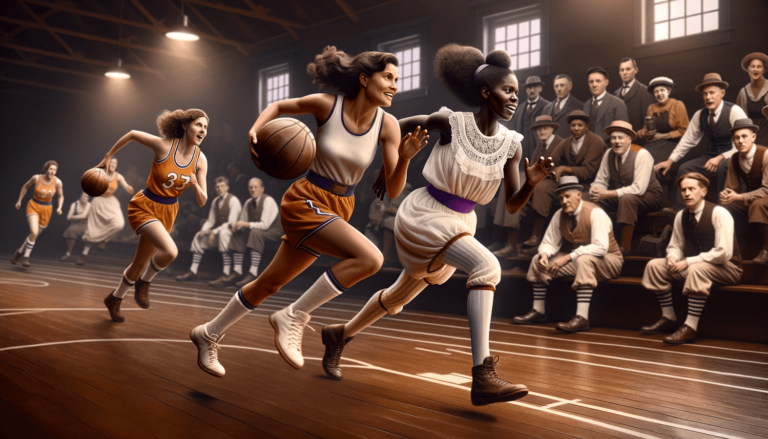
The Role of Women in the Early Years of Basketball
Written by: Basketball Universe
Last updated:

🏀 Hey basketball enthusiasts! Buckle up for a captivating journey through history as we dive into the role of women in the early years of basketball. If you think you’re a true hoops aficionado, then it’s high time you learn about these pioneering female athletes! Our fun and informative deep-dive will take you from the inception of the game and Senda Berenson’s groundbreaking modifications for women’s play, to the trailblazing squads and unsung heroes that laid the foundation for today’s flourishing women’s basketball scene. So, let’s get ready to pay homage to these forerunners who left an indelible mark on the sport we all love. 🏀
The Role of Women in the Early Years of Basketball
In the early years of basketball, women played a vital role in shaping the game and promoting its growth. Senda Berenson, known as the “Mother of Women’s Basketball,” was instrumental in adapting the rules to create a version suitable for female players. She introduced the women’s game at Smith College in 1892, just a year after the sport’s invention. Women’s teams were soon established at other institutions, spreading the game among female athletes. These pioneering women helped build the foundation for today’s thriving women’s basketball scene and demonstrated that basketball could be an inclusive sport for all.
Thriving in a Man’s World: Women’s Early Entry into Basketball
As we delve into the history of women in basketball, it’s important to recognize the challenges they faced in a predominantly male-dominated sport. Despite the obstacles, a number of determined women emerged to contribute their talents and efforts to the growth of the game. Let’s explore the true pioneers of women’s basketball history who made their mark and sowed the seeds for future generations of female athletes.
Senda Berenson: The “Mother of Women’s Basketball”
One titan of basketball history is Senda Berenson, a physical education instructor at Smith College. When basketball was invented in 1891 by James Naismith, Berenson quickly realized its potential for female players. Just a year later, in 1892, she adapted the original rules of the game to be more suitable for women, pioneering the first women’s basketball game at Smith College.
In Berenson’s version of the game, she divided the court into three sections, with players restricted to their designated areas. This modification aimed to limit physical contact and promote teamwork among players. Berenson’s rules laid the groundwork for women’s basketball and earned her the well-deserved title “Mother of Women’s Basketball.”
The Birth of Women’s College Basketball Teams
Building on Berenson’s momentum, several other educational institutions began cultivating women’s basketball teams. College students embraced the sport, which eventually led to the formation of intercollegiate competition. Mount Holyoke, Sophie Newcomb College, and the University of California at Berkeley were a few of the pioneering institutions that established women’s basketball programs, forever changing the landscape of women’s sports.
The Trailblazing Women’s Basketball Teams of the Early 20th Century
With a foundation in collegiate play, women’s basketball made strides on multiple fronts. The early 20th century saw women’s club teams gain popularity and prominence, contributing to the spread and influence of the sport.
The Girls’ Commercial High School Team: Pioneering the Amateur Scene
The Girls’ Commercial High School, located in New York City, formed one of the first public high school women’s basketball teams in 1909. This team was a trailblazer in women’s amateur basketball, dominating the competition and winning three consecutive championships from 1914 to 1916. They established a benchmark for the potential of women’s basketball while breaking down barriers to female participation in sports.
The All American Red Heads: Breaking Ground in Professional Basketball
The All American Red Heads, crowned the first professional women’s basketball team, were formed in 1936. This remarkable team not only challenged gender norms but also showcased extraordinary talent and skill, garnering an impressive fanbase across the nation. Their playing careers, along with their signature red-haired wigs, brought the game of women’s basketball to the forefront of people’s minds and attention, drawing in spectators who had never before seen women compete professionally.
Creating a Global Platform: International Women’s Basketball
As the popularity of women’s basketball grew in the United States, it was only a matter of time before the sport reached international audiences, expanding the game’s influence and fostering even greater global diversity.
Establishing International Competition
With the expanded reach of women’s basketball, global competition grew naturally. The first major international competition was the 1953 FIBA Women’s European Championship, which saw ten nations participate in the tournament. The Soviet Union defeated Czechoslovakia in a closely contested match to claim the inaugural title.
Building on the success of the European Championship, the FIBA Women’s World Cup (formerly the World Championship) began in 1953. Continuing to grow in scope, the first-ever women’s Olympic basketball competition took place in 1976, with the USSR beating the United States in the gold medal game.
Pivotal Figures in International Women’s Basketball
With the global expansion of the women’s game, international players made their mark on basketball history as well. Ukrainian-born Olga Sukharnova, French super-star Edwige Lawson-Wade, and Croatian legend Razija Mujanovic are a few names that will forever grace the annals of basketball history. By cultivating homegrown talent and leveraging opportunities to compete globally, these trailblazing women helped break new ground for female athletes around the world.
The Evolution of Women’s Basketball: Leaving a Legacy
As we look back at the role of women in the early years of basketball, it’s critical to recognize their influence on the sport’s growth and the impact they made on future generations. Women’s basketball has evolved into a dynamic and influential game, setting the stage for breathtaking talent and spirited competition around the globe.
WNBA and the Modern Era
The establishment of the Women’s National Basketball Association (WNBA) in 1996 brought women’s professional basketball to a new level of prominence in the United States. The league carved out space for exceptional female athletes like Lisa Leslie, Cynthia Cooper, and Sheryl Swoopes to showcase their extraordinary skills, inspiring young girls to dream big and chase their basketball aspirations.
A Platform for Future Generations: Women’s Basketball Today
Today, women’s basketball continues to thrive, thanks to the legacy of pioneers who led the charge in the sport’s early years. With collegiate and professional leagues in place, opportunities for competitive play, and a growing fanbase, the future of women’s basketball is brighter than ever before.
The role women played in the early years of basketball history has left a lasting impact, serving as a reminder of their resilience, determination, and sheer brilliance. It is through their trailblazing efforts that we continue to witness the growth and elevation of women’s basketball on the global stage.
Pioneers Beyond the Hardwood: Women Influencers in Coaching and Officiating
As we celebrate the various aspects of women’s contribution to basketball’s early years, it is important also to recognize the women who impacted the game from outside the lines. Female leaders in coaching and officiating have made significant strides over the years, carving out paths for the next generation of women in the world of basketball.
Lillian M. Ford: A Trailblazer in Women’s Basketball Officiating
Lillian M. Ford was an outstanding pioneer in women’s basketball officiating. With a strong background in physical education, she became one of the first women to take a leading role in basketball refereeing. Between 1923 and 1950, Ford served as a basketball official, working tirelessly to promote the game and advocating for women’s participation. Her commitment and passion for the sport brought crucial diversity and recognition to female officials.
Female Coaching Pioneers: Nera White and Cathy Rush
Nera White was not only a fantastic player but also a brilliant coach. Her innovative tactics and leadership carried the Nashville Business College women’s basketball team to national dominance during the 1950s, further solidifying the importance of women’s basketball in the United States. Cathy Rush, another coaching pioneer, transformed the women’s basketball program at Immaculata College. Under her guidance, the team secured three consecutive national championships in the mid-1970s. By leading and mentoring future generations, these female coaching icons provided inspiration and endless possibilities for women in basketball.
The Unsung Heroes: Lesser-Known Women’s Basketball Pioneers
The names of countless women who have influenced basketball’s early years may have faded from the spotlight but deserve recognition for their significant contributions. These lesser-known pioneers paved the way for more widespread female participation in the sport, opening doors and breaking down barriers.
Eleanor Snell: An Early Advocate for Women’s Basketball
Eleanor Snell, once referred to as “a fiery little woman,” worked to establish a women’s basketball program at Ursinus College in 1927. She continued as the team’s coach for 39 years, spearheading changes in the university’s athletic environment and advocating for the growth of women’s basketball. Her dedication provided an essential platform for female athletes to develop their skills and pursue their passions.
Florence E. Taylor: Pioneering North Carolina Girls’ Basketball
Florence E. Taylor played a pivotal role in the growth of girls’ basketball in North Carolina. Known as the “Mother of Girls’ Basketball” in the state, her involvement in organizing leagues, clinics, and camps facilitated the spread of the sport throughout North Carolina, ultimately inspiring countless young women to take part in the game.
The sacrifices and strides made by these unsung heroes, and many others like them, have left an indelible mark on women’s basketball history. Their passion, determination, and vision planted the seeds for the phenomenal growth and influence that women’s basketball enjoys today.
Frequently Asked Questions
In this section, we’ve compiled some of the most common questions and answers semantically related to this blog post, providing a general overview and concise responses to key points about women’s basketball in its early years. Curious readers can easily get the information they seek to further expand their knowledge of women’s basketball history.
1. Who is considered the “Mother of Women’s Basketball”?
Senda Berenson is known as the “Mother of Women’s Basketball.” A physical education instructor at Smith College, she adapted the original rules of the game to create a version suitable for female players and introduced the first women’s basketball game in 1892.
2. When was the first women’s basketball game played?
The first women’s basketball game, adapted by Senda Berenson, took place at Smith College in 1892.
3. Was the early version of women’s basketball different from the men’s game?
Yes, the early version of women’s basketball had different rules to make it more suitable for female players. For example, the court was divided into three sections, limiting players’ movement to their designated areas and reducing physical contact among players.
4. What were some of the early women’s basketball teams?
Some early women’s basketball teams included the Girls’ Commercial High School Team in New York City and the All American Red Heads, the first professional women’s basketball team.
5. Did women’s basketball exist internationally in the early years of the sport?
Yes, women’s basketball gradually expanded globally, with the first significant international competition being the FIBA Women’s European Championship in 1953. The FIBA Women’s World Cup followed soon after, and later, the first women’s Olympic basketball competition took place in 1976.
6. How did women contribute to basketball aside from playing?
Women significantly contributed to basketball through coaching, officiating, and advocating for the growth of the sport. Figures like Lillian M. Ford, Nera White, and Cathy Rush championed women’s basketball, breaking barriers and creating opportunities.
7. Who organized the early women’s college basketball teams?
Educational institutions such as Mount Holyoke, Sophie Newcomb College, and the University of California at Berkeley were among the pioneers that established women’s basketball programs in the early years of the sport.
8. What was the All American Red Heads team known for?
The All American Red Heads were known for being the first professional women’s basketball team, challenging gender norms and showcasing exceptional talent and skill. They also wore signature red-haired wigs during their games, generating attention and attracting new fans.
9. What is the legacy of women in the early years of basketball?
The legacy of women in the early years of basketball includes the establishment of a strong foundation for women’s basketball, significant growth in the sport, breaking down barriers for female participation, and inspiring future generations of women to take part in the game.
10. How has women’s basketball evolved since its early years?
Since its early years, women’s basketball has evolved into a dynamic and influential game, attracting global talent and competition. The establishment of the WNBA, collegiate and professional leagues, international tournaments, and an increasing fanbase are all testaments to the strides the sport has taken thanks to the pioneers of its early years.
Featured Posts
- No pillar pages found.




